Table of Contents
- Show-and-Tells for 2025
- February 2025
- January 2025
- Show-and-Tells for 2024
- November 2024
- October 2024
- September 2024
- August 2024
- July 2024
- June 2024
- May 2024
- April 2024
- March 2024
- February 2024
- January 2024
- Show-and-Tells for 2023
- December 2023
- November 2023
- October 2023
- September 2023
- August 2023
- July 2023
- June 2023
- May 2023
- April 2023
- March 2023
- February 2023
- January 2023
- Show-and-Tells for 2022
February 2025
There was not a Show and Tell during this meeting due to the presentation of the new “Modeling Topic Discussions”.
January 2025
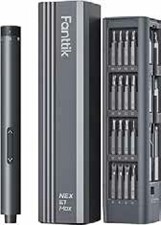
Micheal Zern showed his latest tool. This is a rechargeable screwdriver with a large number of screwdriving bits in a self-contained storage case. The screwdriver has an LED light for the work area and two speeds. This is available from Amazon.
Gerry Glancy shared a tip for holding small screws to a non-magnetic bit is to use a small amount of beeswax. This holds the screw to the bit and allows the bit to be removed easily.
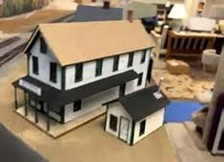

Rich Gibson gave a tour of the added structures at Yarmouth Junction on his layout. He added a section house by the back drop. This is a standard Grand Trunk section house in railroad red paint. He constructed Ruble Hardware, a two story store front with interior display windows. This was a Mount Blue Models kit. Continuing on with another Mount Blue Models kit, in this case a New England farm house. In the foreground is the signature pink house with a newly added garage. The decision has not yet been made on re-painting the pink to another color. Nearer to the backdrop and toward the section house is another house and garage location. The kit is still in partially constructed pieces awaiting shingles, windows, and other details. This is a two story house with the upper floor shingled and the lower floor in clapboard siding. He is hoping to get the buildings together in the next few weeks and start on scenery in the area.
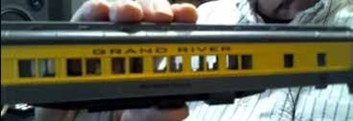

Glenn Runkewich shared some of the difficulties in free lancing a railroad. His railroad needs passenger service and along with that a signature color scheme. He has settled on a combination of the Aspen Gold of the Rio Grande and the Harbor Mist grey of the Union Pacific. This gives brighter color sides capped by the grey. He started with a Rivarossi passenger car and added figures to the interior. To light the interior, he tried a Walthers light board, but it flickered off and on depending on the track power. He found a circuit board by voltscooter, https://voltscooter.com/ . This is a keep alive board with 16 LED lights. The board is equipped with a reed switch to turn the board off/on.
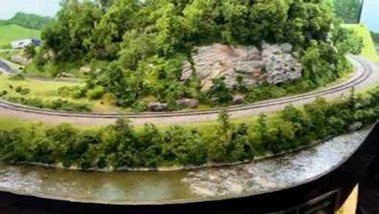
Mark Shifter has been working on water around his layout. He has added water in Scott Creek coming from Sylva, North Carolina with rapids. This is his first rapids attempt. He is working on a shallower river with more rapids. This will have a number of exposed rocks.
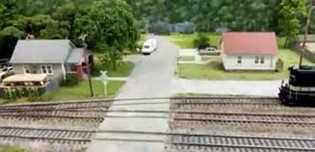
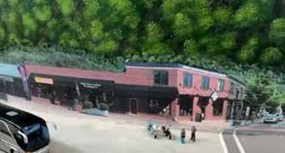
More work has been done on the photo backdrops at Bryson City. The road was extended using photos from Google Earth. He added more detail to the city including Smoky Mountain Harley. He related how he had difficulty with the first application of epoxy and has since been very careful to seal all cracks and any holes prior to using the epoxy.
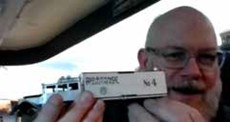
Keith Hayes returned to the discussion with a thank you to whomever was seated next to him at the Gathering of the Elves. It was suggested that to round out his locomotive roster, he should add a Galloping Goose. As luck would have it, one became available.
November 2024
Carl Hodkinson showed his latest version of the Lionel Coal Loader in HO scale. Carl has been working through the Lionel catalogs of the past to bring the animated accessories to life in HO. He used an aquarium valve in the structure to activate the loading process. The hopper is large enough to hold ten (10) carloads of coal with graphite added to prevent clogging. A companion to the loader is an unloader where the coal is dumped into a jar below the layout. This structure is number 22 of the cataloged items he has built.
Paul Brennecke showed us his latest project on his layout. During the judging of his layout, it was pointed out the waste rock from one tunnel was not at the tunnel portal. Paul had installed a bridge over a small ravine immediately adjacent to the portal.
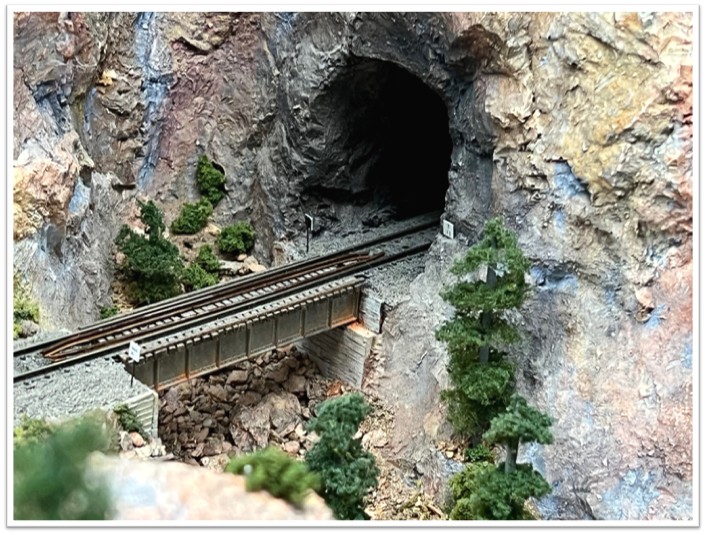
At the RPM meet, Paul found some small culverts at one vendor, Iowa Scale Models, and with a little haggling came home with several.
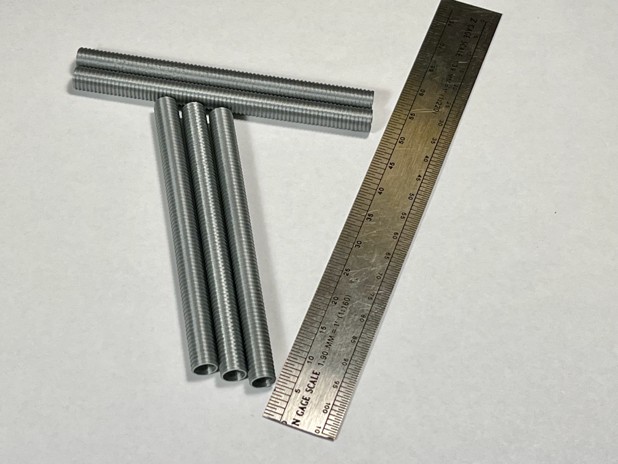
These formed the basis for the fill at the tunnel portal and gave realism to the rock fill.
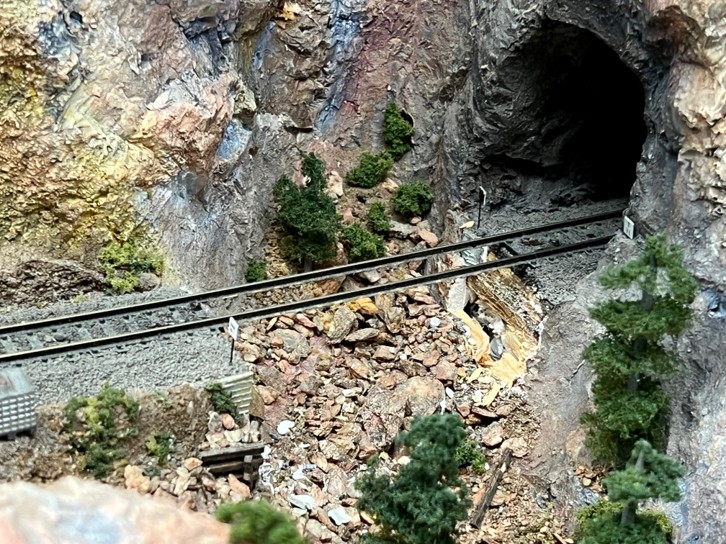
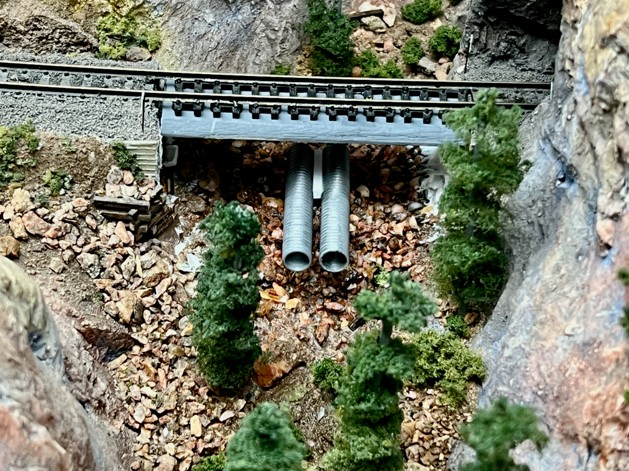
The bridge was removed and replaced with a twin culvert installation and rock fill.
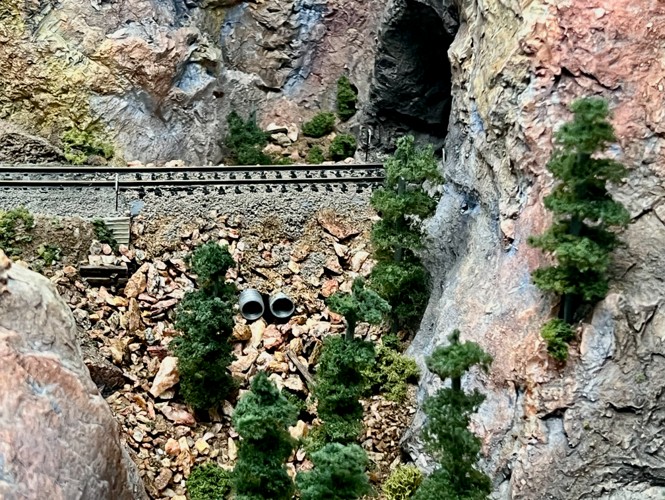
This shows the finished installation. The bridge ties were removed and replaced with normal tie spacing on the Grand Road. The road bed was a piece of Balsa wood formed to the bed shape and ballasted with the standard ballast for the railroad. One should note that no trees were sacrificed for the installation.
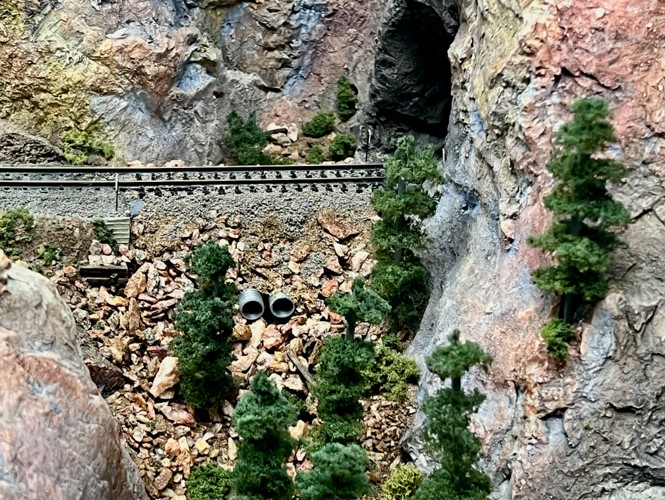
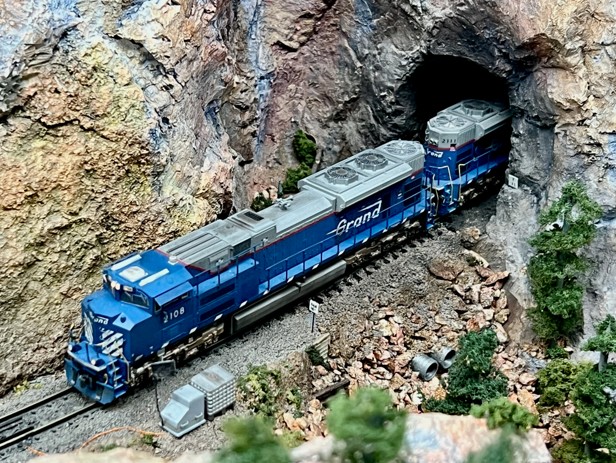
October 2024
Mark Shifter showed working grade crossings with a gate. They were sold at the Greeley RPM meet by Azatrax. They are manufactured by Details+. They are available in HO and N scale. See https://www.detailsplusshop.com/index.html or https://www.azatrax.com/.
Paul Brennecke gave us a report on the Greeley RPM meet. The meeting was held in an empty storefront which did not lend itself to photography. Vendors were arranged on the outside walls with the modeler’s display tables in the center of the space. Small signs identified the modeler and the model subject. Many of Paul’s photos were in the previous edition of the Telegrapher.
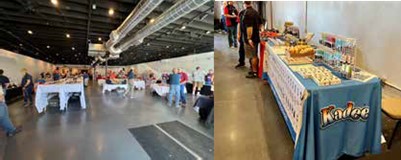
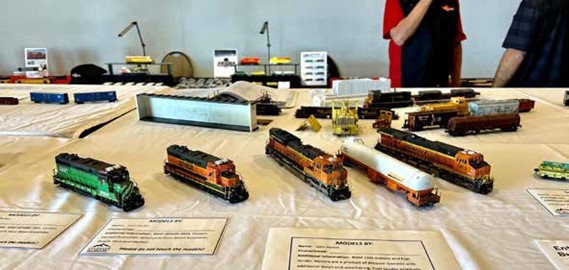
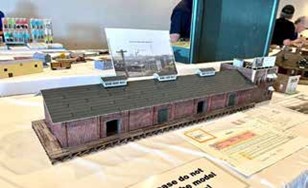
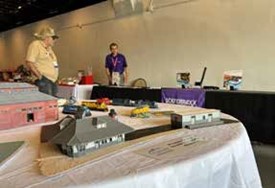
Glenn Runkewich gave his report on the Long Beach NMRA National Convention. He passed around the convention schedule and layout tour information. He noted it was not possible to make a visit to all the open layouts nor was it possible to attend all the clinics you would desire. During his time at the convention, Glenn went to the signaling clinic given by Azatrax. He also attended a clinic on Focus Stacking and invited any interested to come to his layout and practice. He will watch. The next clinic was Kitbashing Tools. His major take away from this clinic was the modelers can cut up the foam backed emery files into any shape you need. Border Crossings was the next clinic attended, and it provided a great deal of insight into the operations at border crossings. This includes the paperwork involved, train crews, and scanning of the trains. The clinic showed photos of the equipment at both the Canadian and Mexican border crossings. The final clinic was on SP/UP operations in the LA area. The presenter worked for both railroads.
The next item was the tours that Glenn took while at the convention. The first one was the Metro Rail Fleet Service Center. This was an interesting tour where cell phone photography was not allowed. This facility does heavy rail metro train maintenance. They prepare cars for shipment overseas for rebuilding. They will be receiving a large number of new cars for the 2028 Olympics.
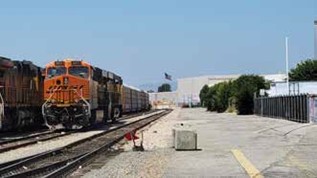
The next tour was the GEMCO yard. This yard is located where a GM assembly plant was located. It is now a classification yard, one of many in the UP system. Much of the equipment was graffitied.
The National Train Show was smaller than usual as it was held at the convention hotel and not in a convention center. Glenn’s most interesting take away from the train show were the Z scale models on two modules. Both of the modules were award winning, one from the Salt Lake convention and the other from the Long Beach convention.
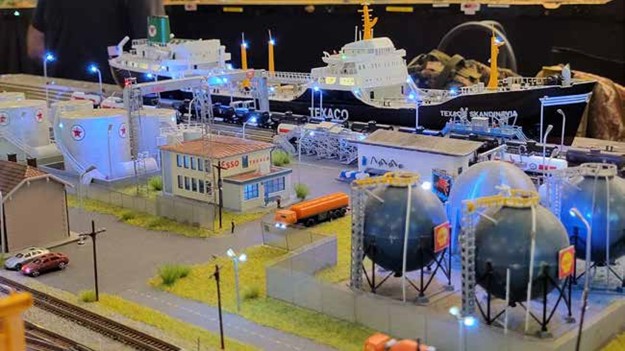
The layout tours were attended as bus tours and were short scheduled. The first layout was Ron Varnell’s HO scale Any Era Western. The layout is located in a small warehouse and is run as a club layout.
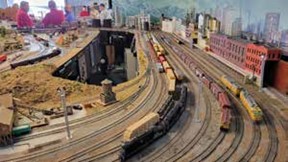
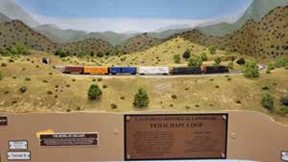
The next layout was the Central Pacific Railway, an N scale layout. It is located in a two-car garage with additional bedroom space dedicated to the layout. This has areas on either side of the garage connected by a model of the Tehachapi Loop.
The next layout on the tour was the Belmont Shores Model Railroad Club. This N scale layout is in an old Army barracks owned by the city. It is a two-story building with the layout on the top floor with meeting, workshop, and module storage on the lower level. The layout is very large and includes their version of the Tehachapi Loop.
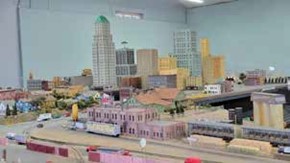
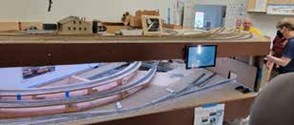
The final layout was the Los Angeles Model Railroad Society. They are in the process of rebuilding as they lost their space and needed to relocate. They have a good size space but are still in the re-construction phase.
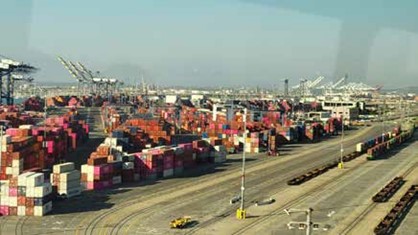
The final item was on the return from the tour, the guests were treated with an overview of the Long Beach Intermodal Yard. This is a massive yard handling 6.7 million containers per year.
September 2024
Gary Ratay showed a cordless rechargeable soldering iron with rapid preheat and an adjustable temperature setting. The temperature control is very helpful for electronic and fine detail work. The rapid preheating is helpful for those who lose patience waiting for the iron to heat up. It is an Amazon sourced product. The editor believes that it is this Amazon product, Cordless Soldering Iron Kit, 5V 8W Digital Display Wireless Portable Solder Iron Pen with LED Spotlight, Adjustable Temperature & Auto sleep Mode, USB Rechargeable Soldering Tools by ANBES.
Carl Hodkins bought in his latest efforts to recreate the antique Lionel trains.
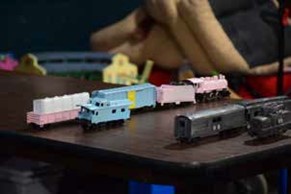
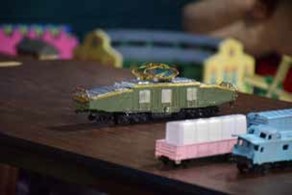
He showed a World War One trench train, the fantasy Girl’s train, and an electric locomotive model styled after Marklin. The trench train model in Lionel is very rare. The Girl’s train is a fanciful mix of colors to appeal, at least in the Lionel marketing minds, to girls. The final model is another unique fantasy model.
Rich Gibson brought in his latest station development. Yarmouth Junction railway station was located at the intersection of the Maine Central Railroad and the Grand Trunk Railway. The junction was at an 80-degree angle and the depot followed with a similar angle. The modeled portion on Rich’s layout is at 60 degrees. This meant a modification to the depot to match the track angle. The model walls are made up of three pieces of wood with the upper and lower walls made of wainscot siding with the mid portion made up of clapboard siding. All the windows and doors were made of strip wood. The roof of the structure is a double sloped with the upper portion at a higher slope than the lower reach of the roof. The roof is hipped with dormers. To develop the shape, Rich used card stock paper to model the roof and to keep the pieces in shape he cut triangular rafter shapes. The shapes formed the basis of the roof and guided the construction of the remainder of the roof pieces. Another defining feature of the depot is the transoms above each window. The transom glazing was replicated by printing the detail on clear sheets and cut to shape. The roof corbels are a curved shape, and Rich sent the drawing to a friend in Seattle who laser cut the shapes to match.
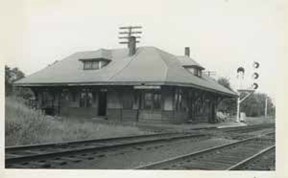
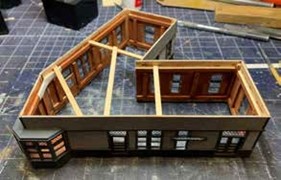

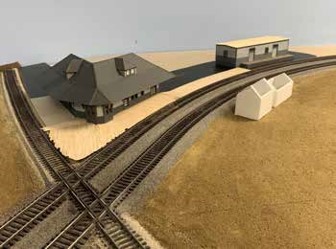
Photos of the RPM in Greeley can be seen by clicking “here“.
August 2024
No Show-and-Tell due to having the Picnic.
July 2024
Paul Brennecke has been spending time in the layout room shooting photographs. As usual he is on point with the composition and highlighting his superb modeling. These four (4) photos are what Paul sent to the NMRA for the 2025 Calendar. Good luck Paul.
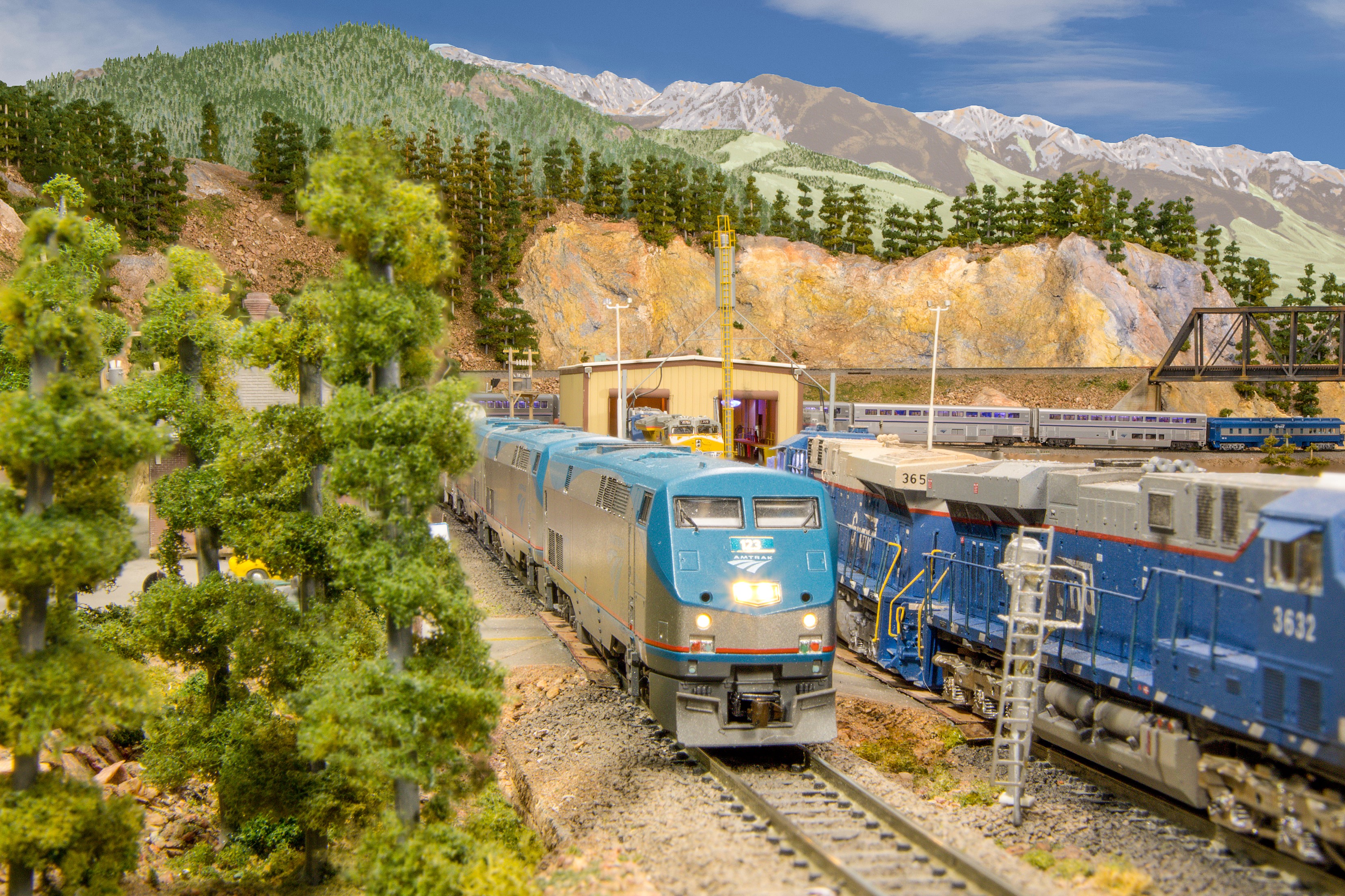
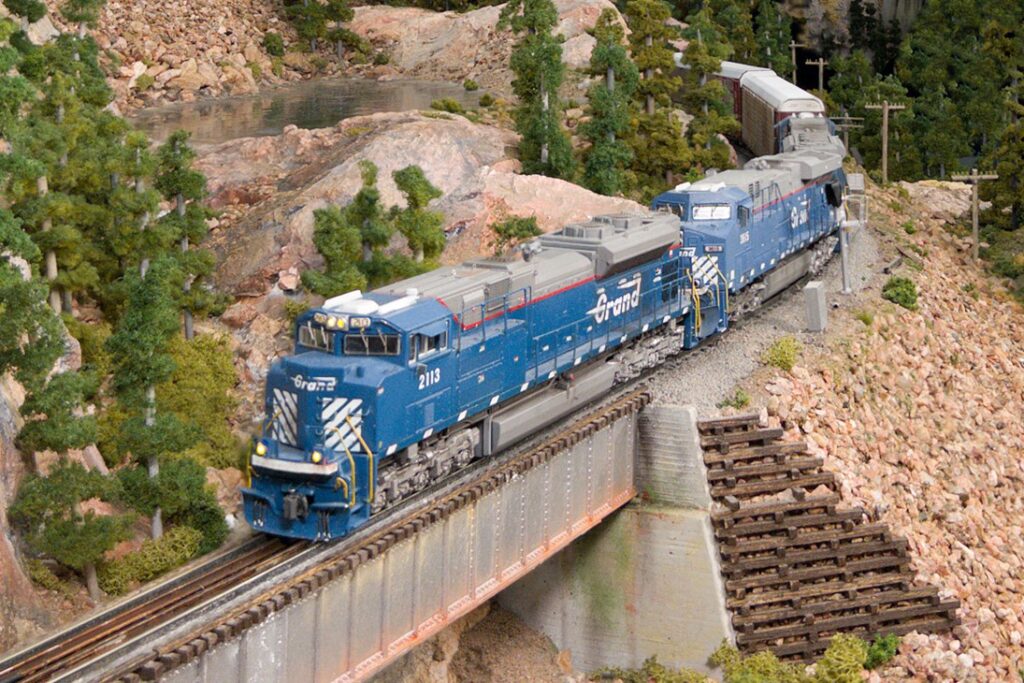
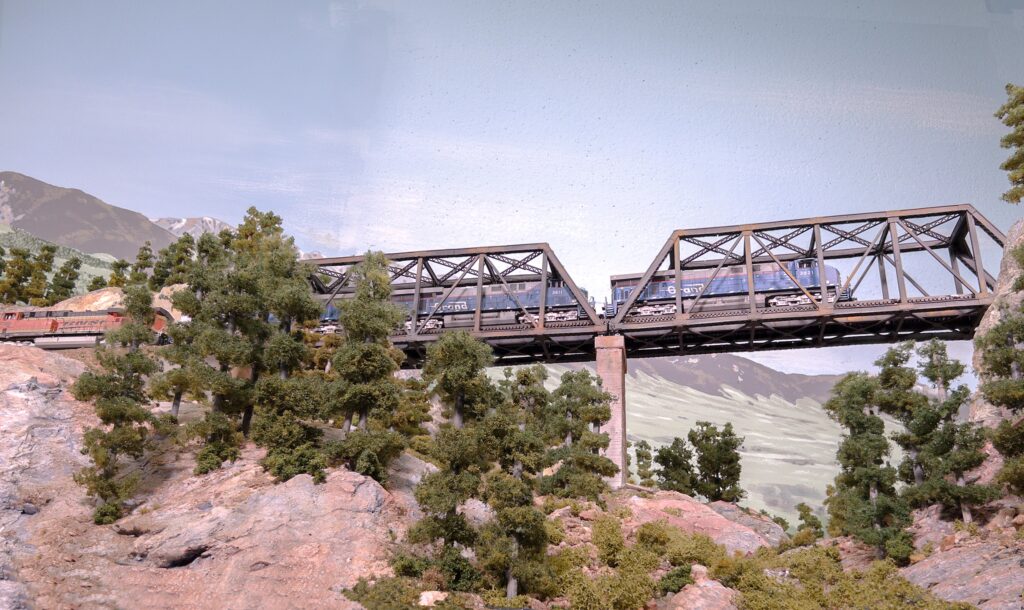
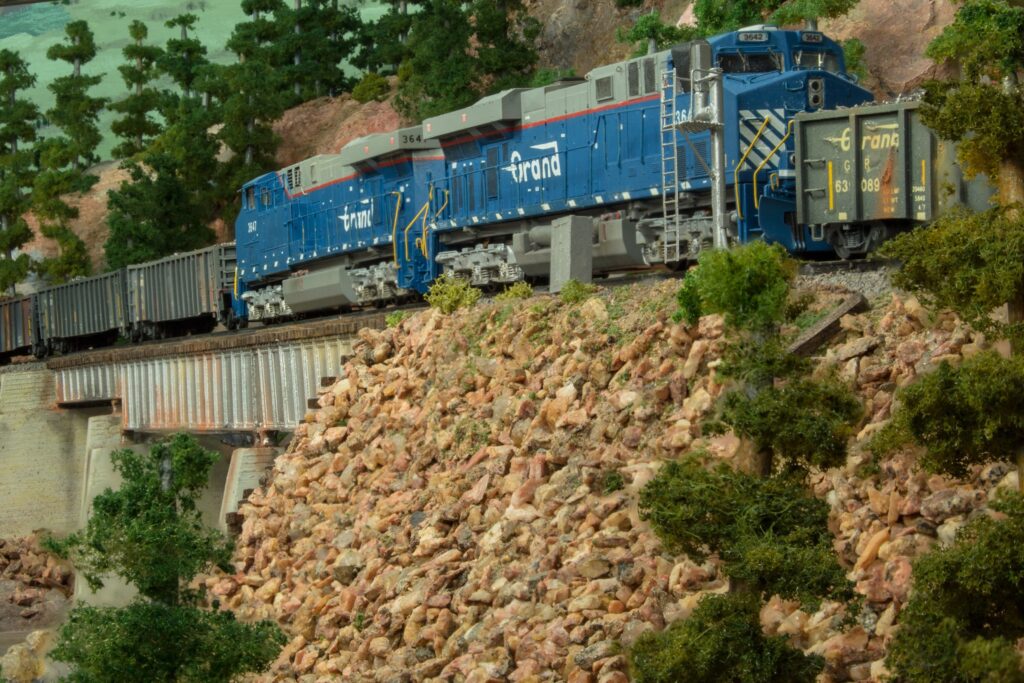
Rich Gibson brought in 3D printed tie/terminal strips. These add a longer and more sturdy area for rail to feeder contact. You can contact him if you need more information.

June 2024
Carl Hodkinson is on a quest to make HO versions of the Lionel animated accessories. He brought in four examples that he has been working on to complete the catalog offerings.
The first is a dairy with a loading and unloading area for milk cans. The action replicates an accessory in the Lionel catalog.
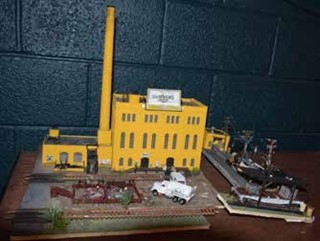
The next item was a yacht delivery system. A modified Atlas turntable that will rotate 30 degrees allows the empty car in and after rotation a loaded car comes out.
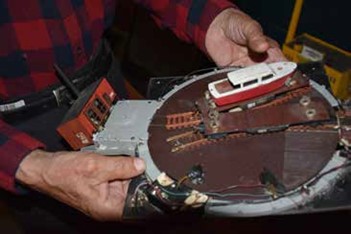
The next was an observation car with an action figure. At each stop the figure would emerge from the car to the end of the platform and when the train begins to move again the figure disappears into the car.
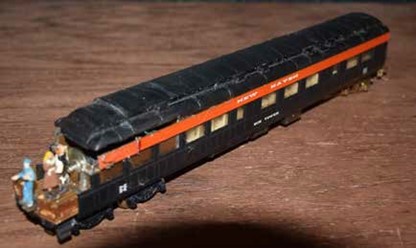
The last example is the Captain Morgan boat repair and chandlery. The unique item of this model is the signage that came from no less than three bottles of rum. Yo! Ho! Yo!
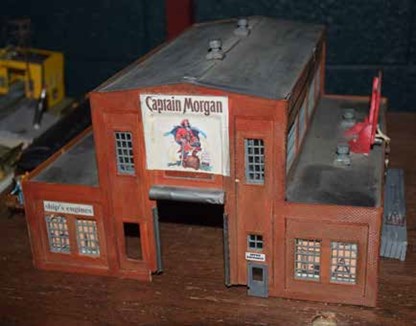
Rich Gibson presented his latest shoe factory addition. This is an effort to meet the insatiable need of his layout for buildings. He had a part of a previously constructed kit that he wanted to use on the newer addition to his layout. The building had an over-the-track bridge but in this instance, he needed to provide the landing for the bridge. It just happened that he located a postcard of a factory that tied the buildings together and appeared similar to the model. Freeport Maine was the location of a number of shoe factories. The modeled Freeport needed shoe factories. He mocked up a building and drew the factory building. It has distinct features.
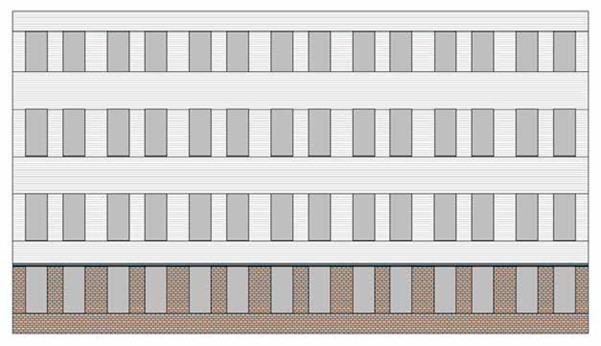
The lower level is brick supporting a three story wood frame structure. The lower level has evenly spaced windows while the upper floors have paired window spacing with two different sized windows. The first challenge was to find suitable windows. He located Tichy windows that were close but were masonry windows needing the addition of a frame for the wood structure.
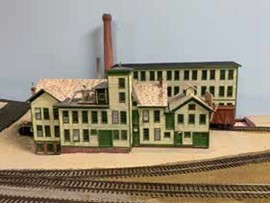
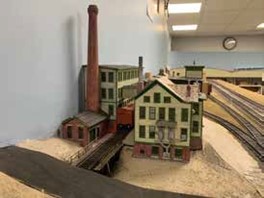
Rich added the power house to the rear of the four story addition. Since the post card showed a water tower, Rich constructed a Tichy water tower kit with very fine details and will add that to the scene. This is an amazing use of on hand materials and kits and blending the whole into a unified scene.
May 2024
Glenn Runkewich showed off his adaptation of the Avalanche Mine. Tucked into a corner of his layout is a small mining district. The mine buildings are a re-purposed metal kit, Buckhorn’s Mine Processing Plant. This is a metal model that Glenn constructed in the past. The model was soldered together and had crude windows. Glenn updated the windows with new window castings that mostly fit the openings. He wanted to light the interior and he used tape to seal the seams and disguise the miss fit windows. To add details in the main building, machinery scenes were printed to scale on yellow paper to give the appearance of dim incandescent lights within the structure. The tipple was part of the Bachmann coaling and sanding complex. To finish the scene, tanks were added from the Walthers industrial tank set. Since that scene needed mine cars, those were added to the scene from the excess detail parts stash.
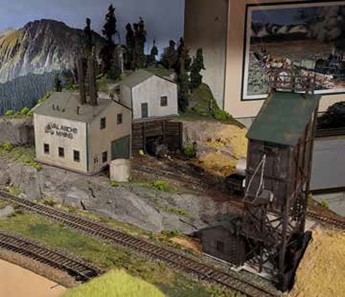
The mine entrance is set into a crib wall constructed from craft dowels purchased in a craft store. These dowels were stained a dark color and formed into walls by glueing the back with lines of white glue. This made a nice wall. The opening was framed with heavier timbers.
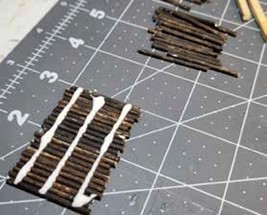
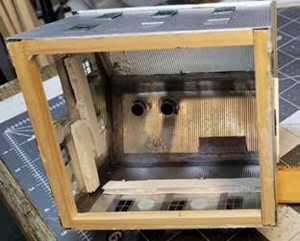
Glenn Gibson brought in his latest tool tip for holding small parts. This is magnetic based alligator style clamps. The set comes in a metal box with can serve as a base for the clamps. He used this to paint his herd of Hereford cattle. This is available from Amazon as Maptipjoy metal painting stand base holder with 12 pieces of magnetic base alligator clip sticks. These will be helpful in a number of ways in the modeling room.
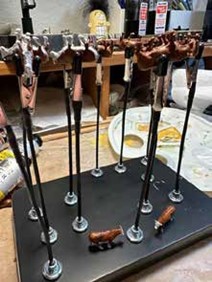
April 2024
Mark Shifter shared a new product Silhouette Silflor MiniNatur shrubbery material that can be separated into individual or small groups of plants. This has a stem with the flocking at the top. This gives a little more height to the small plants in the foreground of the scene. This is available at: https://www.eurorailhobbies.com/. So, check this product out as it comes in a number of scales.
Paul Brennecke, MMR gave us a demonstration on his technique for constructing N Scale Conifer Trees. Paul’s railroad is set in the Rocky Mountains, and the trees are primarily conifers. His layout has 3000 trees, not 4000 as reported previously. He uses toothpicks for the trunks which are 35 feet high in N scale. He paints the picks grey. The foliage material is Woodland Scenics Foliage in dark green. Again, there are various colors available, so you may alter the colors for your efforts. He hacks the foliage material into branch structure clumps about the size of one of your fingernails. Do this over a container to collect the dislodged bits of foliage. The shape of the pieces is not that important. The irregularity helps define the natural tree shape. The dislodged foliage material is used to define the crown of the tree. Just dip the toothpick into white glue and into the foliage bits and the crown is formed. The tree is formed by taking the pieces of foliage and jamming them on the toothpick. Space the branches in an irregular pattern along the length of the trunk. The pieces deform as they are forced onto the trunk. This is okay as you are wanting the variation of the pieces. Take the completed trees and mount them on foam or cardboard. Spray the trees with cheap hairspray to anchor the foliage bits and the assembled trees. The key is to plant them on the layout, and you will not be able to see the trees for the forest that is developed.
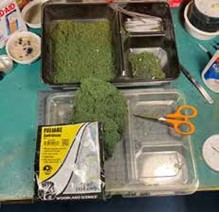
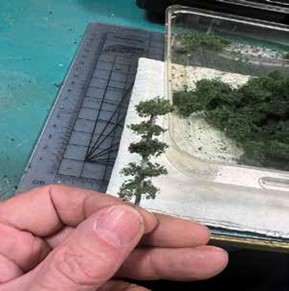
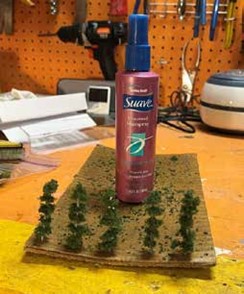
March 2024
Rich Gibson showed the progress on the Bates Mill in Lewiston, Maine. Don Meeker had a large operating layout but it was dismantled and rebuilt in the 3 year Covid period. As a part of the Livingston expansion of Rich’s layout, a space was made available for the Bates Mill. This was a complex of several buildings that would need to be compressed to fit in the available space. Rich supplied Don with photographs of the buildings, the Sanborn map, an indication of the buildings that were important to model, and the aerial view of the complex. This information was sent to Don about two months ago. The area on the layout for this complex is 46 inches by 4 inches.

Prior to our meeting, Don indicated he had finished the complex. The completed model fills the available space to match the prototype. A little adjustment may need to be made to the one structure for the track clearance. The buildings were constructed of foam core board with textured brick sheet as the facing. The brick wraps into the window and door frames to match a completed masonry structure. The windows and doors on the complex were left over “scrap” box parts. To give life to the complex the dock areas were modeled open with figures, cotton bales, shipping boxes, and dock equipment. This gives the box car spots for the operations. The detail on the structures is very well done with interesting details.


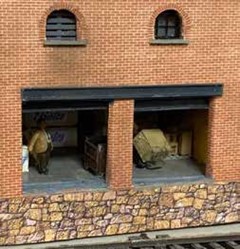
The second part to the show and tell was another floor show. Rich has laid a lot of track recently and was present at Glenn Gibson’s layout where the tracks were being laid and ballasted. A common problem in ballasting the track shoulders is that the roadbed shows through the ballast layer. Rich solved this problem by painting the roadbed shoulders with craft paint in a complementary ballast color to hide any areas of thin ballast. This takes a short amount of time and simplifies the ballasting operations. Rich demonstrated this in the middle of the crowd and over a catchment on the floor. We need to keep the area neat. One side of the track was ballasted without the paint and the other side ballasted with a painted shoulder. The difference is easily seen. Rich uses a sprinkle bottle made from any container with a screw on lid. He punches holes in the lid to allow the material to come out easily but in a controlled fashion.
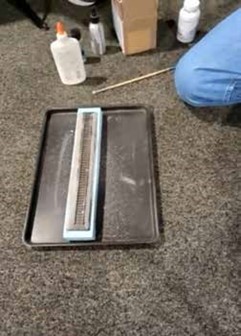
February 2024
Carl Hodkinson brought in his latest diorama with lights and smoke, really fog. It is powered by 3 separate power sources. He asked for comments on his work. Great to see Carl bringing in his creations.
January 2024
No Show-and-Tell this month.
December 2023
No Show-and-Tell this month due to the Christmas Party.
November 2023
The SS Jack Brody was in attendance for the meeting. So not only did we see the presentation on the model, but we could also study the model itself. The rigging on the slides was one thing, but seeing the complicated mass of lines in person is something else. Thanks, Glenn, for bringing this to us.
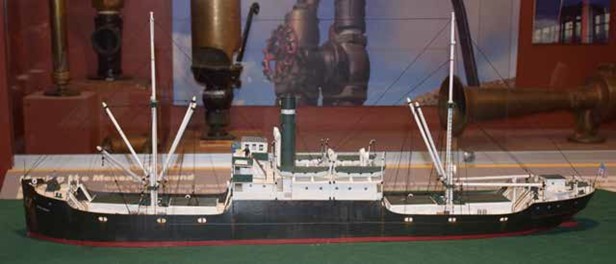
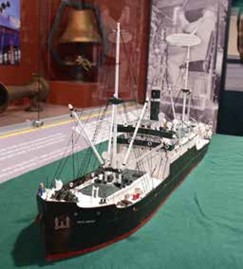
October 2023
No Show-and-Tell this month.
September 2023
Paul Brennecke brought us his submission to the NMRA Calendar Contest. Each year beginning in April, the NMRA requests submissions of photographs for the next year’s calendar. Paul usually submits some of his work for consideration. What is unique about Paul’s photos is the point of view. Using his phone to take the photos he has a vantage point about 15 scale feet above the terrain. This gives a more natural view of the model railroad as if the viewer were on the ground.




Paul replaces the sky with alternate photos of the sky to eliminate the shadows cast on the backdrop sky by trees. So, when you see the sky in Paul’s photos, it was placed there by Paul and his editing. If you see Paul out taking photos just smile and wave as you go by. Thanks for the preview of your photos to be included in the calendar. Apologies to Paul for the small images in the Telegrapher.
Roland Lawrence has been working on a Front Range Division website to give us more visibility. Take a look at https://front-range-division.org. In an effort to populate the website, Roland is requesting feedback and information you would like to add to the site. It would be great to add more FRD member layouts and information on the layouts to the site. In that instance, Roland is requesting that interested individuals send pictures and/or video, and a summary of what scale, room size, location, railroad name, setting/era and other information to describe your railroad.
Please review the site and send feedback or submissions to frd.nmra.meeting@gmail.com.

Rich Gibson brought in his recently acquired train order hoop. This is a wooden hoop with the train order paperwork clipped near the hoop which was transferred on the fly to the engineer or fireman in the locomotive. The hoop was caught on the arm of the train personnel, and the orders removed with the hoop dropped along the tracks beyond. This was a pretty precision move, and the result was bruising on the arm. The hoop was replaced by a “Y” shaped device with the orders suspended between legs of the “Y”. This is an interesting piece of Railroadiana. Thanks for sharing.
August 2023
No Show-and-Tell due to having the Picnic.
July 2023
Don Widrig brought in a Peco crossover with a broken frog lead asking for suggestions. A number of ideas were brought forth with the most promising being to attach the lead from the underside of the crossing. He also brought with him some Lionel trains that need a good home.
Gerry Glancy followed with the latest installment of the Standard Gauge / Narrow Gauge (SG/NG) Legerdemain on the Dueling Gauges Railway and Navigation Company. As you may remember last month, a SG/NG crossing was fabricated. This month we reviewed the track work for a Dual Gauge Industry, The Oriental Refinery. No commercially manufactured turnouts were available. So with starting with a Peco Narrow Gauge turnout, one may add a third rail to the outside of the diverging route to service a standard gauge siding.
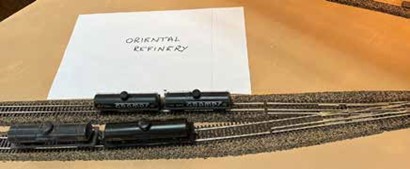
Once you have mastered the technique, additional sidings can be accommodated. The Salida Stockyard is one of those industries.
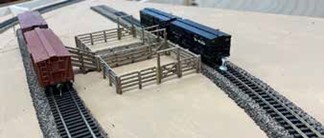
One starts with the turnout and using careful Dremel surgery grafts a third rail to the outside of the turnout on the diverging route.

For this to be a successful effort, the use of track gauges for the entire turnout is necessary.

Rich Gibson brought in a photographical study from the Jackson Thode Collection. These photos were taken in Pueblo, Colorado on December 21, 1956, which represents the last day of the Denver and Rio Grande Western Railway standard gauge steam power. The Collection shows D&RGW No. 1185 in action.
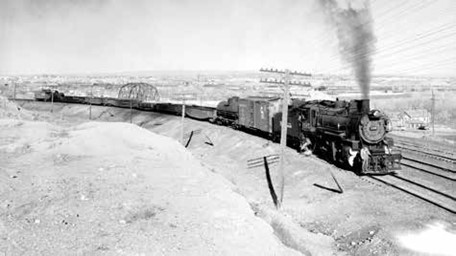
The Collection continues on to the scraping of the locomotive in Pueblo. There is a large pile of scrap accumulated along the tracks. It was a very sad day. The only good thought is the scrap lives on in wire, fence posts, structural shapes, and rail from Colorado Fuel & Iron.

Glenn Runkewich brought in the Tichy flat cars he has been modeling. These are nice looking models, but have little opportunity to add weight to be anywhere close to the NMRA standards. He went into his junk box, and found part of a track cleaning car and another tank model to add to one car. The other car received a load of two diecast vehicles to round up the weight on the car.
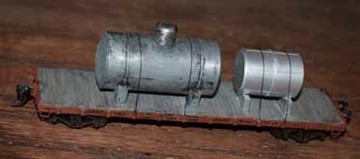
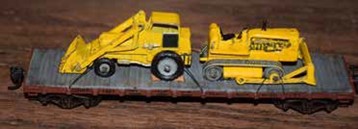
June 2023
Gary Ratay brought up some developments on European railroading in that they are putting into service passenger cars which load at platform level. This is to meet a goal the major station stops will be reduced from 5 minutes to 3 minutes. No word on the German translation for “Mind the Gap”.
Also from Gary Ratay, brought in a Ryobi one inch belt sander, model PSD101B. This is an 18 volt tool using the standard battery and is varible speed. Looks like a great tool for sanding and shaping in the tight spaces on the model railroad or modeling work. The next tool was a Ryobi USB Lithium Power Cutter Kit, model FVC51K. This is a power rotary cutter with replaceable blades and a small lithium battery. This is suitable for cutting cardboard, plastic, leather, and most importantly the bubble packaging prevalent today. Another product is the Ryobi Lithium Rotary Tool Kit, model FVM51K. This is a USB rechargeable kit. This tool performs like the heavier and less maneuverable rotary tools. The last product was a new find on Amazon of a rechargeable mini soldering iron. Just search on the site for rechargeable soldering pen as there are a number of different models for you to choose from reasonable pricing. This for Gary was a must have as the former soldering iron met with the floor and under a foot.
May 2023
Glenn Gibson started off the Show and Tell, by showing off his latest model of a Rexall Drug Store for his version of Trinidad, Colorado. The Hausman’s Riverside Drug Store was a brick structure on the bank of the Purgatoire River. The building is still there, but the use has changed. In Glenn’s version of the store the drug store occupies the first floor of the building, and the upper level is Donna’s Dance Studio. The structure is a mixture of DPM kits. The store front is from a Carr’s Parts building kit with the back and sides from the Robert’s Dry Goods kit. Dry Goods provided the rear loading dock and entrance for the dance studio. The structure was painted with Rustoleum red, grey, and white primer, finished with Tamiya light grey, Rustoleum Khaki, and the final coat was Roberts Brick Mortar. The roof was covered with Walthers Roof Texture. The Rexall sign is a Miller Engineering animated sign, and the other lighting is the Woodland Scenics “Just Plug” system components. The window signs were printed on transparency film. Other signs on the building were printed on plain paper and sanded down before being applied. The first floor interior was a City Classic Drug Store scene scanned and resized to fit the larger width of the building. The second floor figures are Woodland Scenics Swinging Sensation dancers. To highlight the second floor scene, a skylight was constructed of Tichy Train Group windows mounted on a scratch built curb. This is an interesting structure with a good level of detail for the entrance to the Trinidad model.

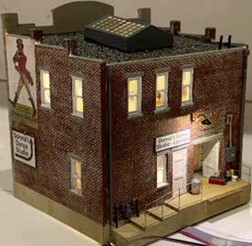
Gerry Glancy gave us an update on the Dueling Gauges Railroad and Navigation Company. The Keddie Wye from his last layout has been integrated into the current layout as an operational element. The auto reverser has been installed to keep the trains moving through the wye. At the time of the January layout tour, peninsula bench work had been constructed, but the track was not in place. With this meeting’s update; track is in place, and an active staging yard is operational. In keeping with the historic nature of the Denver area railroads, the narrow gauge line operated into Denver until 1942. The difficulty is the track plan for the Dueling Gauges Railroad necessitates the crossing of the narrow gauge line and the standard gauge line. In this instance, the rails cross at a 30º angle. That is easy. One can just find a narrow gauge and standard gauge crossing. No, you cannot. Get an Atlas 30º crossing and modify one leg to narrow gauge width. Just remove the mid-section and reattach the resulting parts to the correct gauge. One problem is the ties no longer line up to the realigned rail. Just offset the pieces to make the rails line up. The resulting piece is a little unusual but installed in the layout and ballasted, the appearance is good and operationally the crossing works as intended. Good job in making the railways work for you.

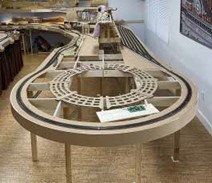

Carl Hodkinson brought in a little piece of history to show us. In the 1930’s, Lionel produced a wind-up toy handcar featuring Mickey and Minnie Mouse. This was during the Depression Era, and it was an effort to keep Lionel in business. The box contained the wind-up toy, sections of track to make a circle, and cardboard inserts printed to look like stations. The toy cost $1.00 and sold 250,000 units. The toy was reissued in the 1960’s with some differences to keep collectors from backdating the new version to the historic units. Interestingly, no mention of Lionel was on the box, it was only labeled Walt Disney. As both versions of these were wind-up toys, the spring would break and make the operating piece of the toy useless. The circular track was durable, and it begged to be used by a Lionel train. Carl brought in the 1960 version of the toy complete with the colorful box. This is an amazing instance of Disney promotion and Lionel desperation making a collectable piece of Railroadiana.

Glenn Runkewich related the recent events on his railroad and other photo equipment improvements. Needing to pay of all this, he has added vacuum cleaner salesman to his resume. He located a cordless rechargeable hand vacuum to use for cleanup on his model railroad. This is the Bissell model 29869 found on Amazon or other retailers. This is a small unit with sufficient suction to clean up static grass or ground foam without disturbing other materials.

April 2023
Rich Gibson rehabilitated a collection of Life-Like trees in an unrealistic turquoise color. He put a wire brush to the flocking and removed as much as he could. This had the effect of removing the foam but also rough shaping the tree. You can at this point re-shape the tree to better mimic natural trees. The resulting armature was painted the go-to color Rust-Oleum camouflage brown. This is a flat brown color and is useful in many model railroad applications. The armature was sprayed with 3M Super 77 adhesive and coated with green flocking. This added back the needle texture and improved the color of the tree. One may use a variety of foam colors to add variation to the trees. The result is a low cost solution to adding trees to a model railroad or diorama.
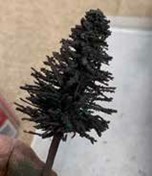
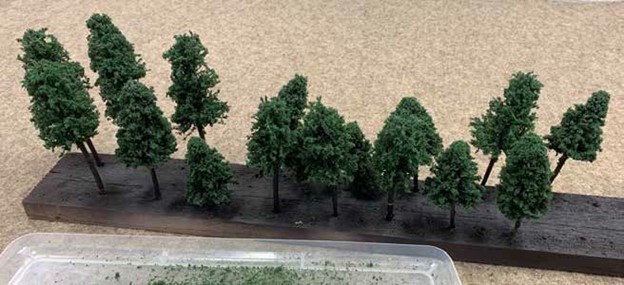
March 2023
Glenn Runkewich showed us his latest creation, the Runkewich Wedge. This is a rail car brake/holding device to immobilize a car or a string of cars on an incline. The components are simple, a ¼ inch square wood block with a small ¼ inch block of 0.100 x 0.250 styrene. Glue the styrene to the underside of the block and paint for visibility. Glenn models in HO scale so the dimensions can be adjusted for other model scales.
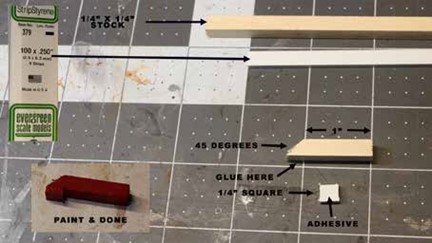
Glenn Gibson was able to display with Roland’s assistance his model of the Hotel Trinidad. This model is to be a part of Trinidad on Glenn’s AT&SF layout. The model features the wall painted signs on the side of the building with an animated HOTEL sign on the opposite side. The animated sign is a Miller Engineering sign replicating graphic neon signs of the past. Glenn explained the sign has a number of different animations which are user determined. See the animated version of the model on the transmittal email.

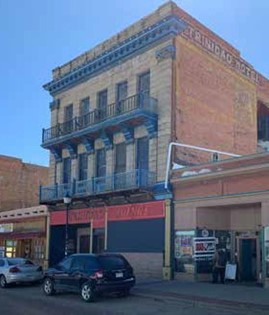
February 2023
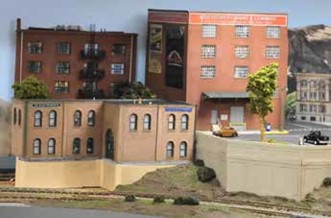
Glenn Runkewich brought us up to date on his latest efforts in the downtown area of his layout. This unit was the third of the downtown units with one more planned. The building is a train shed style building with a double staging track below the buildings. The structures are made up of Design Preservation wall modules and a Walthers Williams Electric Motor kit. The structures are lit and populated. In a building with sufficient room, Glenn will layer the photos in the windows with curtains and people, direct to the window glazing and on a foam board frame behind the windows additional photos to fit the space. A single LED lights the structure in a lightbox with the light coming through the photographs and the windows. On the narrow structure against the back drop, Glenn is constructing a lightbox with Plastruct tubing and layering all the photographs direct to the window glazing. Glenn added a Walthers Vintage Fire Escape to the building flat to add some depth to the flat. He is a little sorry he decided to add to the building as it was a difficult build. Each landing for the escape includes three parts to make up the railing, the landing itself, and an interior rail to protect the opening. Each stair section includes two railings as well. He added this to the one wall of the Williams Electric Kit, so the window spacing was compatible with the escape stair layout. The Williams Electric Kit has yielded four buildings for the city center by not following instructions. The kit is well designed with alignment pegs for the windows greatly simplifying construction. One building is the narrow flat against the backdrop with the fire escape. Montgomery Wards to the left of the flat was constructed using two walls with a loading dock.

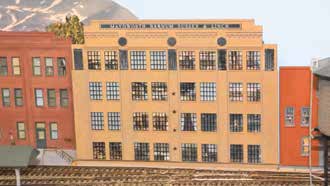
The front wall of the Williams Electric building was truncated to a garden height and added to another portion of the city scene. The art deco style entrance has been saved for more building efforts.

The final wall was a large blank brick sheet with an added loading dock area, decals, and added into the corner is a chimney. We look forward to more adventures in kit-bashing.
Don Widrig showed us his latest acquisition on the road to building a coffee table N scale
layout. His passenger service will be handled by an occasional Santa Fe doodle bug. The
unit was listed on eBay and was a DC only unit. It has now been converted to DCC with the
addition of a Digitrax decoder.
January 2023
Glenn Runkewich showed us his latest modeling efforts. This started as a Walthers kit, but Glenn added details and artfully weathered the structure to add interest. A wonderful addition to his layout, Glenn admitted he followed the instructions on the model. He built this while on the road at his cabin in Wyoming. This gives us all ideas on “bite-sized” projects that can go mobile in our travels.

Paul Brennecke’s franken engine built of SD 40-2 and SD-70 parts with a unique exhaust system. The Grand #1030 was constructed on the SD 40-2 Kato chassis after modifying the frame to allow for the SD-70 sloped engine section to fit over the remaining weight. We will see the locomotive on the Denver N-Trak group layout at a train show near you.

Rich Gibson’s newly acquired fleet of New Haven DL-109 locomotives in HO scale. An interesting locomotive that was approved for construction during WWII and used extensively by the New Haven in passenger service. Some were used by the Bangor and Aroostook hauling potatoes in northern Maine.
